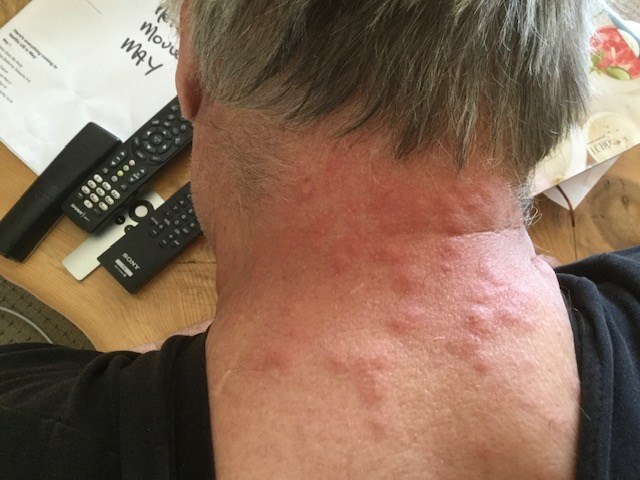Some Tiny residents want the municipality to address what they see as a public health hazard.
And they’re not alone as other area residents wrap tape (sticky side out) around trees in the hope that gypsy moth caterpillars won’t be able to reach the tree canopy for sustenance.
But it’s the itching, rashes and welts that initially leave people wondering whether they’ve accidentally strode into poison ivy that have many scratching their heads and other body parts.
“If you have tried to purchase some hydrocortisone cream in a local pharmacy recently, chances are you have come up empty handed,” said Tiny resident Andrew Combes.
“You can put that down to a burgeoning number of cases of the rash caused by the gypsy moth caterpillar.”
Over the past couple of weeks, the area has been inundated with seemingly millions of small black gypsy moth caterpillars emerging from their overwintering egg clusters.
Gypsy moths are invasive creatures that feed on tree leaves, destroying tree growth and taking away trees' ability to produce new leaves.
Living Green Project director Andee Pelan said it is anticipated that trees in Simcoe County will be severely affected this year.
“The European gypsy moth has a seven- to 10-year cycle and many trees in Barrie are going to be under attack,” said Pelan, who’s charitable organization is based in the city.
“This year will see a peak in its population cycle. Typically, when populations rise rapidly, they are usually followed by a crash from a host-specific virus or fungus.”
While many people are using the technique of applying tape around the tree with the sticky side up to catch the small caterpillars, Pelan says it isn’t necessarily the best idea.
“No, we have not been using the tape trick as there have been quite a lot of reports of other wildlife, like birds, getting trapped as well. We will, however, be using the burlap wrap-trap technique in a couple of weeks though. This will include physically picking the caterpillars off the tree and drowning them in a bucket of soapy water."
Combes said many Tiny residents can still recall the outbreak of last summer, which they say limited their ability to enjoy being outdoors.
“The infestation of backyards and treed areas defoliated swaths of our tree cover and contact with the hairs and silks of the caterpillars caused many residents to suffer acutely itchy rashes,” Combes said.
“This year is proving to be even worse for many area residents, the incidence of allergic reaction rashes is very high.”
As well, Combes would like to see municipalities such as Tiny Township employ an agent to significantly reduce the gypsy moth population.
“In particular, the natural bacterium known as BTK [Bacillus thuringiensis] is very effective applied as an aerial spray onto the tree canopy,” he said, pointing out the caterpillars ingest the bacterium and die shortly afterward using a treatment that’s been deemed safe by the federal government.
As well, Combes pointed out that there have been a number of deputations made to Tiny council over the past few years after massive outbreaks of the caterpillars.
“Whole swathes of forest and greenery were devastated through almost complete defoliation by this invasive foreign species,” he said. “Council have relied on advice from the Severn Sound Environmental Association and arborists in considering their response to the problem.
“This advice is based on the health of the trees and forests that make up so much of our local landscape. What they have singularly failed to consider is the human health consequences associated with this invasive pest.”
Fellow Tiny resident Susan Barbieri agrees with Combes’ assessment of the situation.
“We have a cottage on the shoreline which is being bombarded with what looks like the beginning stages of the Gypsy moth caterpillars,” Barbieri said.
“They are covering every surface of our cottage, deck, chairs, furniture, etc. I'm not so concerned about losing a tree here and there, I'm more concerned about their bite, which leaves you scratching for weeks.”
Combes said council should consider first and foremost the health of its residents.
“In a matter of three days, I have harvested from friends and colleagues a startling array of stories on how their lives are very materially affected by these caterpillars and many photographs of the rashes they have caused, from mild to severe,” he said.
“After months of lockdown and stay-at-home orders finally seem to be nearing an end, we are now faced with many of our outdoor spaces being rendered literally unusable unless one is prepared to run the risk of the allergic reactions caused by the caterpillars, their hairs and silks.”
-with files from Shawn Gibson, BarrieToday
